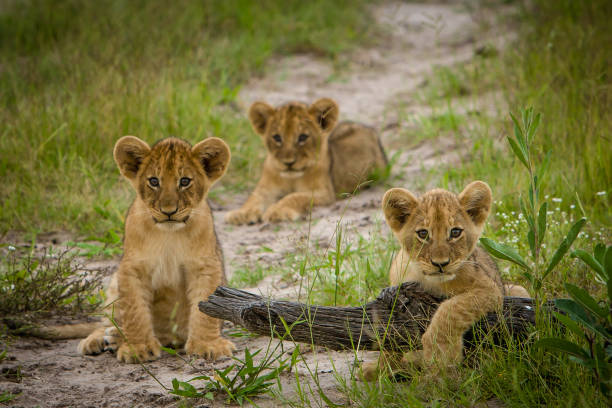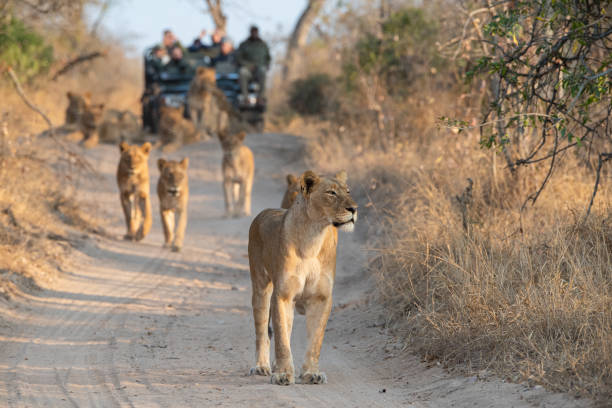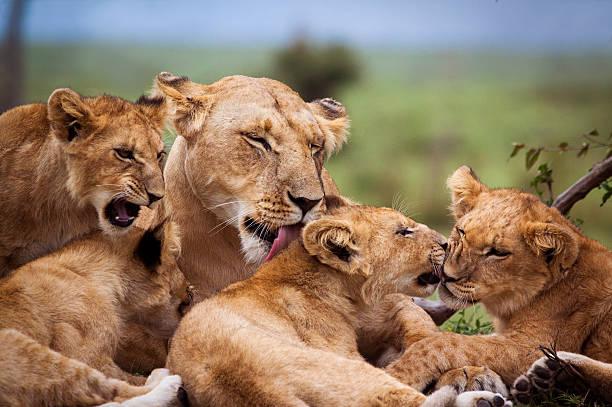Enter the domain of lions, the mighty kings of the savannah who rule supremely. Since tigers and lions are wild creatures, their attitudes toward people can differ. These large cats are generally not thought to be amiable or good pets. They are predators by nature, and a variety of circumstances, including their upbringing, socialisation, and unique personalities, can affect how they behave. Humanity has been captivated by their incredible beauty, strength, and mysterious charm for ages. However, beneath their regal exterior is a complex web of interpersonal relationships and fascinating actions. Come along on an engrossing journey into the complex world of lion society, where stories of tenacity, hierarchy, and familial ties resound with every roar.

The Social Structure of Lions
The pride, a close-knit family unit made up of related females, their young, and a coalition of one or more dominant males, is the centre of lion society. In addition to providing security, this structure is essential for hunting and raising young.
The main hunters in the pride are female lions, or lionesses. Using stealth, speed, and coordination to their advantage, they cooperate in concert to bring down enormous prey, such buffalo or wildebeest. With their enormous size and strength, the male lions, in the meantime, are mostly concerned with protecting the pride's members and territory from outside dangers.

The Role of Dominant Males
Male dominators are very important in lion society. They fight ferociously to become the leader of a pride, frequently fighting other males to gain the upper hand. A dominant male guarantees his genes are passed on to subsequent generations by gaining access to both territory and girls after he is successful.
However, the tenure of a dominant male is not indefinite. As they age or become injured, younger, stronger males may challenge their leadership, leading to power shifts within the pride. This dynamic keeps the gene pool diverse and ensures that only the strongest and most capable males are in charge.
Cub Rearing and Social Bonds
Within the pride, lionesses form strong bonds with one another, often related by blood. These bonds are essential for raising cubs cooperatively, as lionesses will nurse each other's young and share in the responsibilities of protection and teaching.
Cubs are born helpless and rely entirely on their mothers for care. As they grow, they are gradually introduced to the pride's dynamics and learn essential survival skills through play and observation. This upbringing within the pride fosters a sense of community and cooperation among its members.

Communication and Behavior
To communicate with one another, lions use a wide range of vocalisations and body language. Communication is essential in lion culture. In addition to indicating power and defining territory, roaring is used to coordinate hunts. Snarls, grunts, and growls are also typical ways to communicate; they can be used to show anger, submission, or dominance.
The behaviour of lions in the wild can be observed to provide important insights about their social dynamics and unique personalities. Every encounter offers a window into the subtleties of lion culture, from comical kittens fighting in the grass to the solemn presence of a dominant male assessing his territory.

Conservation Challenges
Lions are well-known as symbols of beauty and strength, lions face several obstacles to their survival in the wild. Africa's lion populations are declining as a result of poaching, habitat destruction, and conflict between human-world and wildlife. To protect these amazing animals and guarantee their survival on the savannah for upcoming generations, conservation efforts are essential.
Gaining insight into the behaviour and social structure of lions might help one appreciate these amazing animals even more. Lions enthral us with their majesty and motivate us to safeguard their continued existence in the wild because of their intricate family relationships, communication styles, and conservation problems.
There are several different responsibilities involved in volunteering with lions, including tracking, data collecting, and habitat upkeep. Possibilities include teaching local communities about coexistence, monitoring lion populations, and supporting conservation programs. Volunteer programs are frequently provided by organisations, allowing people to help with lion conservation efforts while also obtaining important practical experience and having a significant impact on the preservation of these magnificent animals.










